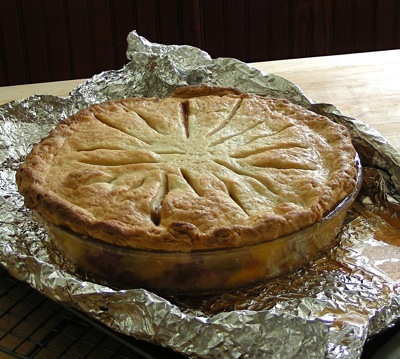Extending the Rhubarb Season (plus Rhubarb Peach Deep Dish Pie)
Did you keep cutting off the rhubarb flower buds, doing your best to extend the season by preventing

Rhubarb flowering instead of making pie material
If so, welcome to the club of “if only.”
Just about every rhubarb grower I know is convinced that removing the flower stalks will
a) keep the edible leaf stalks from growing tough and
b) encourage the plant to produce more of them,
and they are abetted in this belief by most of the published information on rhubarb growing, including that from reliable sources like universities and extension services.
Nevertheless, (a) is untrue and (b) applies mostly to the following season.
Preventing the formation of seeds does conserve the plant’s energy, resulting in a few more leaves, but most of the energy goes to root formation – and to making more flower buds which should, again and again, be removed as soon as possible to keep the plant strong for next year.
Why doesn’t flower-thwarting improve and extend the harvest? Because the flowers are a symptom, not a cause. Rhubarb gets tough, stops making leaves and starts blooming all for the same reason: hot weather.
Nothing to be done about that. But that said, active management can make a big difference in yield and quality.
It looks like no management is needed; rhubarb is famously forever. Neglected plants on former farmsteads keep right on growing for decades, even as gardens return to field and woods start closing in. The ones at our place in Maine were already enormous when Lois had the bulldozer guy move them to their present location in 1964.
But as rhubarb crowns get more and more crowded, stalks get thinner and flowers come sooner. If that seems to be happening at your place, it’s time to divide the plants. (Early spring, with an axe if necessary.)
Also, everything you’ve ever heard about rhubarb being a “gross feeder” is true. Give the plants balanced fertilizer in early spring or a heavy dose of manure after the harvest is over, or both. And keep them well-mulched to conserve moisture and prevent weeds. Just because they tolerate competition and survive drought doesn’t mean they’re happy about it. Plants that have ample water, plenty of room to grow and very fertile soil to grow in will make more and larger leaf stems.
Variety can also play a part. Other things being equal, old fashioned standards like MacDonald (which is still widely sold), switch more easily from stalk to bloom than new varieties like Valentine. The difference isn’t enough to warrant removing plants that are doing well, but it’s something to keep in mind if you’re just starting out or are, as in our case, finally getting rid of something that never earned its keep.
Rhubarb Peach Deep Dish Pie

Actually, there would be heavy cream on it before there was a fork in it.
Jut part of my fall from locavorian grace; once it’s summer fruit season anywhere in the US, I’m a goner. Peaches, nectarines, cherries…
Conveniently, the first peaches and the last rhubarb just barely overlap.,.
A 9 inch diameter x 1.5 inch tall straight sided baking dish
One crust’s worth of pie pastry
Filling: 3 cups rhubarb, in 1 inch chunks
3 cups peeled peaches or nectarines, in roughly 1 inch chunks
¾ cup (1 small canning jar) peach preserves – see note
pinch of salt
2 teaspoons small grain tapioca
No step numbers needed. Heat the oven to 375 – 350 for a glass pan. Mix the filling ingredients, put ‘em in the dish, top with the pastry and slit generously. Place dish on foil lined pan to catch drips and bake – 45 minutes to an hour depending on your oven.

If it isn't full enough to drip, it doesn't have enough fruit in it
Note: I used my own peach preserves, hence less sugar and more peach than the usual commercial. There was still enough sugar for us, but tastes, preserves, and peaches themselves vary. If you have a sweet tooth you might want to add about ¼ c. sugar. If you plan to serve this with ice cream it’ll be plenty sweet enough as is.
Final note: Other people’s manias are a wonderful thing. I can tell you REAMS about rhubarb, much of it conscientiously footnoted, simply by sending you to rhubarbinfo.com.
Note: For a long time, the site appeared to be floating ghostlike, without active maintenance, which was vexing because there was no way to thank its creator.
No more; he’s updating like mad, so for those of you who have visited the earlier version and assumed it was a done deal, be sure to go back (and give Dan a big pat).
Disclaimer: I’ve never met the guy; I’m just grateful.















Since you’re talking about rhubarb, I thought you’d like to see a recipe that I tried from epicurious.com. I make a lot of fruit tarts, but this may have been the best tasting one ever. That is, if you like rhubarb.
You can find it by clicking on the following link:
http://www.epicurious.com/recipes/food/views/Open-Faced-Rhubarb-Tart-105041
I think I used a regular pie dough recipe for the crust, but the one included is a richer butter crust. Your choice.
If you try it, let me know what you think.
Thanks Davene!
Maybe you can tell from the post that I DO like rhubarb… and “best tasting ever” is quite the encomium. Now I just have to remember to look back next year; our rhubarb has had it, in Maine as well as New York.